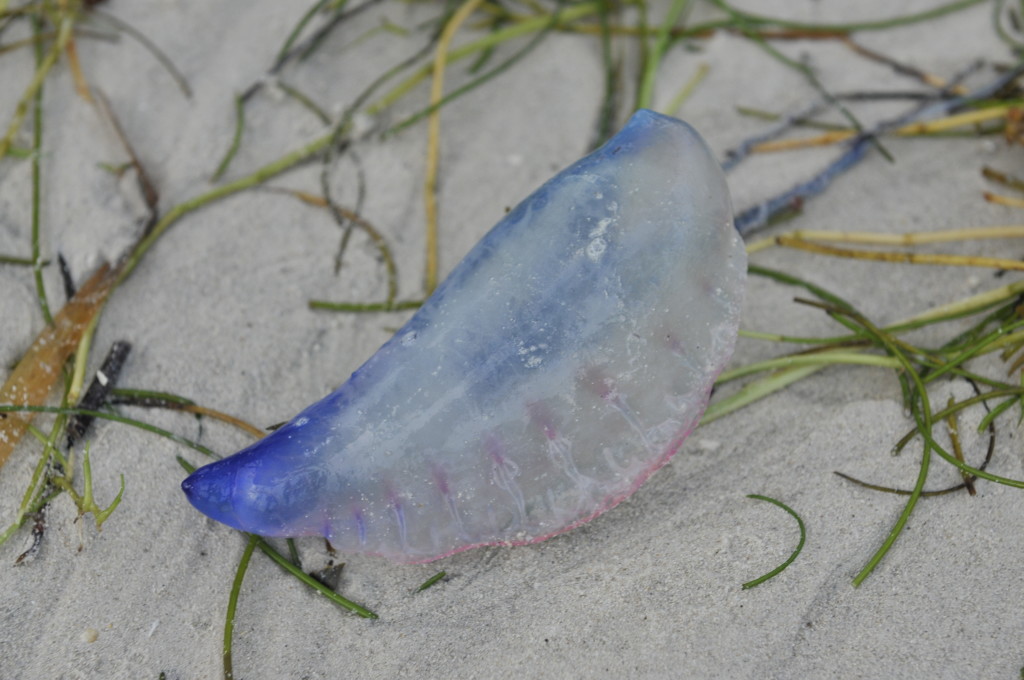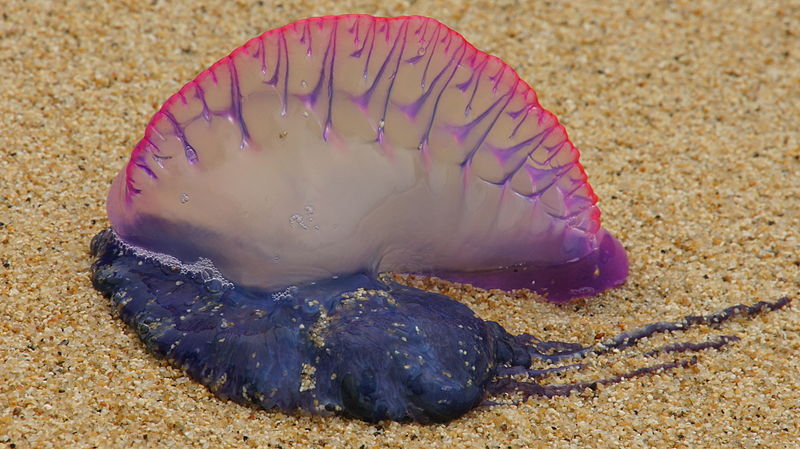Species spotlight is an ongoing series highlighting creatures that we find interesting for one reason or another. Past subjects include sharks, bark beetles, and a beautiful garden spider.
This week Sarah and our brother are on vacation (yes, again, those lucky bums!) in Florida. The main purpose for their trip was to visit family friends, but they used a couple of free days to venture down to the Florida keys. I have never been and it was a first for both of them. They reported back that although it was more crowded than expected, the beaches are as beautiful as everyone says with one extra surprise – they got up close and personal with a Portuguese Man of War! I guess it was only appropriate since they were going to visit our Portuguese-speaking friends.
Man of War is abbreviated as MoW throughout this post. #lazy
After hearing that our brother had a near miss with the creature, I immediately started researching them, and was so surprised by what I learned that I knew this would make a great subject for a species spotlight. My mind was blown the moment I learned that a Portuguese MoW isn’t a jellyfish, it’s a siphonophorae. Siphonophorae are marine animals that look like individual organisms, but are actually colonies composed of many individual animals. In this case, the Man of War is a colony of four distinct individuals, or zooids! Zooid is the technical term for a single animal that’s part of a colonial organism.
The Zooids
As you’ll see, each zooid has a specific role to play in sustaining the colony or siphonophorae.
Pneumatophore – the gas-filled sack that floats near or above the water’s surface and gives the organism its name because when fully inflated its said to look like ancient sailing ships called Portuguese Man of War. The pneumatophore is clear with a blue, purple, or pink tinge and gives the organism its name. A siphon on when end of the pneumatophore releases air quickly when the organism has to go under water to avoid predators.
Dactylozooid – the defense/attack organism. The dactylozooid’s tentacles average about 30 feet in length, but can be over 150 feet! The tentacles are constantly moving about in the water fishing for prey. They use venom-filled structures called nematocysts to sting and paralyze prey, usually small fish. After a successful catch, the dactylozooid’s tentacles move the fish to within reach of the gastrozooid.
Gastrozooid – this organism’s polyps surround the food caught by the dactylozooids and secrete an enzyme which breaks down the fish’s proteins, fats, and carbohydrates.
Gonozooids – this is the organism responsible for reproduction.
Predators
Surprisingly, there are some marine animals that prey upon the Man of War. These animals are a common component of the loggerhead turtle’s diet. The MoW’s sting cannot penetrate the turtle’s thick skin. The Mola mola, blue sea slug, and purple snail all feed on the MoW. Perhaps surprisingly, the slug and snail both live on the surface of the ocean, allowing them to come in contact with the MoW.
Habitat
The MoW is at the mercy of the winds, ocean currents, and tides because it has no means of propulsion. They are most commonly found in the open waters of warm tropical and subtropical oceans, but can be found much farther north and south depending upon the prevailing winds and currents. Strong winds can drive them to shore, and it’s likely that when one MoW is found there will be others. For example, they were a common sighting along the Atlantic Coast last summer.
The Dreaded Sting
As our brother now knows, the MoW’s sting is painful. If at all possible, avoid any MoW you see, even those that have washed up on shore and appear dead. A dead MoW or its detached tentacle can remain potent for days.
The MoW’s sting rarely causes death (although this is possible), typically, the pain just lasts a few hours and it leaves red marks that may last for 2-3 days. However in more serious cases, venom may travel to a person’s lymph nodes creating a more intense pain, or the individual may experience extreme fever, shock, and interference with heart and lung function.
An individual that is stung may look like they were hit with a whip. This is not from any physical force, but the skin’s reaction to the venom released along the line where the MoW’s tentacle came into contact with the person.
After being stung, the immediate best course of action is to remove any tentacles that may be stuck to your skin and then douse the area in salt water. Don’t rinse the area in fresh water, this may release more venom and make the sting worse. When removing tentacles, don’t touch them; use another object to scrape them away. Studies have also found that soaking the sting in hot water, preferably with Epsom salts, can help to reduce the sting’s painful effects.



